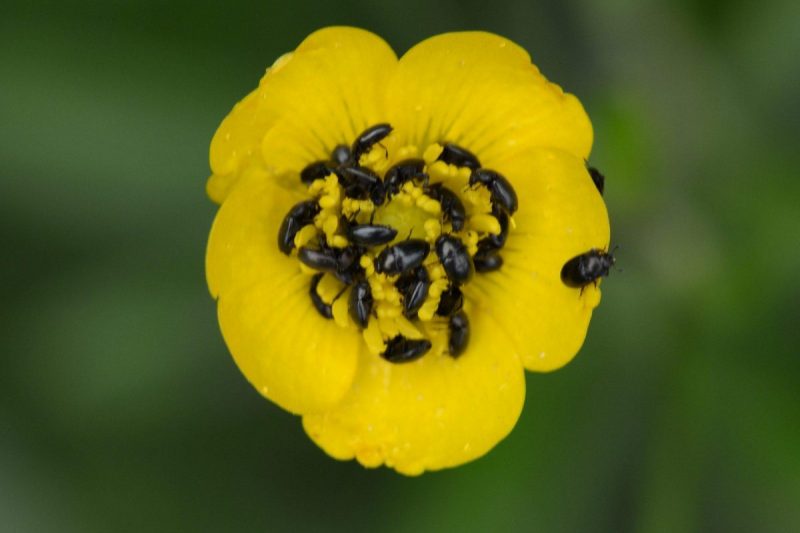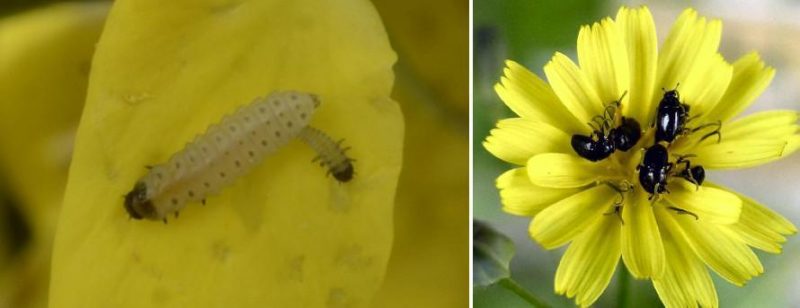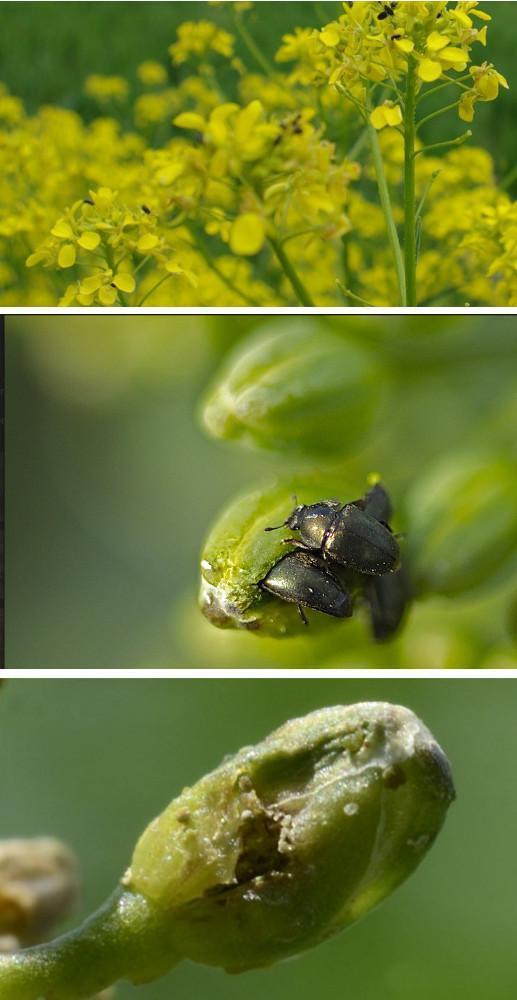Pollen beetle (Meligethes aeneus) – pest management

The common pollen beetle, Meligethes aeneus is widespread in Central and Northern Europe, America, Central Asia, and Africa.
Description. The adult has an oval body, 1.5-3 mm long. The dorsal side is convex, black with a glossy, greenish-metallic appearance, and covered with a fine gray pubescence. The larva is an oligopod. It has a white body, covered with black warts, and when fully developed it is 3.5-4 mm long.
Biology and ecology
The pest produces one generation per year and overwinters as an adult in the surface layer of the soil, under plant debris, or at the edge of forests. It appears in April when certain species of spontaneous flora bloom. The floral elements represent their food source: willow, plum, dandelion. After the formation of flowering rapeseed stems, the adults migrate on them and continue feeding. After copulation, at the beginning of April-May, the females lay eggs in stages in the flower buds of the host plants. The females perforate the flower buds and lay 1-2 eggs, the total number reaching up to 300-400 eggs.
The larvae appear when the flower buds open and feed on the floral organs. At full development, which lasts 3-4 weeks, the larva pierces the flower bud and descends into the ground to build a “room” of earth particles in which it transforms into a pupa. During the months of June-July, the new generation of adults appears, who, after a feeding period of a few weeks, go into hibernation.
Damage. It causes damages especially to cruciferous vegetables, rapeseed, and mustard, feeding on their floral elements. Adults feed on the floral organs of various wild and cultivated species of the Cruciferae, Ranunculaceae, Leguminosae, Compositae, Rosae, and Umbelliferae families. The buds are thus destroyed. The larvae feed only on the floral organs of cruciferous vegetables. In the case of massive infestation, especially in cool springs, up to 10-15 larvae can be found in a single flower.
Pest management
As measures to prevent and reduce pest populations, it is recommended to perform deep autumn plowing, after harvesting cruciferous vegetables, to prepare a suitable crop, to destroy the spontaneous host flora for this pest, to cultivate early varieties, and hybrids, etc.
The common pollen beetle has several natural enemies of economic importance, such as the Clivina fossor Fall ground beetle, which can destroy up to 65% of the common pollen beetle’s pup and larvae.
Rapeseed crops should be monitored from the beginning of the bud formation and up until the silique formation. It matters a lot when the plants finish their dormancy period and how developed they are. Because for a poorly developed plant it can be more difficult to compensate for the loss of flower buds.
Chemical treatments must be applied when the adults appear, at the beginning of the formation of floral buds. The economic threshold must also be taken into account: 3 adults/plant for healthy and vigorous plants and 1 adult/plant for less developed specimens.
Treatments should be performed with specific insecticides.
Recommended products
-
You can find products on a different store
Change Store -
You can find products on a different store
Change Store -
You can find products on a different store
Change Store -
You can find products on a different store
Change Store -
You can find products on a different store
Change Store -
You can find products on a different store
Change Store -
You can find products on a different store
Change Store -
You can find products on a different store
Change Store -
You can find products on a different store
Change Store -
You can find products on a different store
Change Store -
You can find products on a different store
Change Store -
You can find products on a different store
Change Store -
You can find products on a different store
Change Store -
You can find products on a different store
Change Store -
You can find products on a different store
Change Store -
You can find products on a different store
Change Store -
You can find products on a different store
Change Store -
You can find products on a different store
Change Store -
You can find products on a different store
Change Store -
You can find products on a different store
Change Store -
You can find products on a different store
Change Store -
You can find products on a different store
Change Store -
You can find products on a different store
Change Store -
You can find products on a different store
Change Store

















































































































































































































































































































































































































































